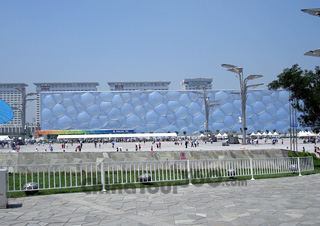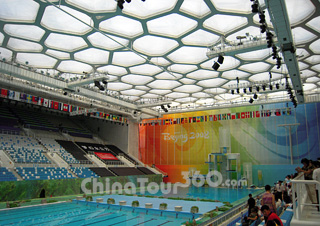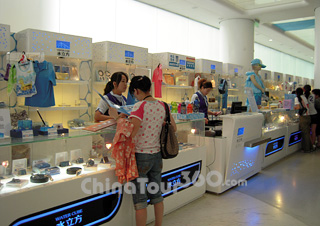The National Aquatics Centre, also known as 'The Water Cube', is one of the most dramatic and exciting venues to host sporting events for the Beijing Olympics in 2008. This landmark building of the Beijing Olympic is located inside the Beijing Olympic Green axially related to the National Stadium on the north part of Beijing Central Axis.
The notion of the structural design originates from the natural formation of soap bubbles which give a random and organic appearance. To achieve this, research was undertaken by Weaire and Phelan (professors of physics) into how soap bubbles might be arranged into an infinite array. The seemingly simple cube is the mingled product of Chinese tradition and modern technology. As far as Chinese are concerned, nothing can be accomplished without norms or standards. The holistic harmony and unity can be achieved as long as things are done in the good order. Influenced by the traditional idea that the earth is square and the heaven is round, the idea of making it cuboid is conceived. The Water Cube and the Bird's Nest reinforce each other in historic and cultural features of the city of Beijing. Such a cube best embodies the multi functions of the National Aquatics Center.
To bring the scheme to life, the individual bubbles were integrated into a plastic film and tailored like a sewing pattern. An entire section was pieced together and then put into place within the structure. There are interior and exterior films. The plastic film was then inflated and continuously pumped.
Comprising a steel space frame, it is the largest ETFE clad structure in the world with over 100,000 square meters (24.7 acres) of ETFE pillows that are only 0.2 mm (1/125 of an inch) in total thickness. The ETFE cladding allows more light and heat penetration than traditional glass, resulting in a 30% decrease in energy costs.
The membrane structure has been made full use of in the construction of the Water Cube. It is the bran-new architectural style in 21st century. Its advantages are obvious. Firstly, it has strong heat insulation. Secondly, it is easy to be restored. In case it is poked by the shot or something sharp, the monitoring computer will display automatically. If there is a hole in it, only the sticker is enough to put it together. Thirdly, this kind of material is pretty light and free from dust, the material itself has the function of drainage, pollution discharge and the desiccant.
The National Aquatics Center was the venue for swimming, diving, synchronized swimming and water-polo final during the Olympic Games. It has a capacity is 17,000 seats, of which 6,000 are permanent and 11,000 are temporary for Games. After the Games, it has become the venue for various activities such as aquatic sports, swimming, fitness and recreation.
The Water Cube is an eco-friendly structure combined with humanist and environmental protection conception. It aims to creating the most favorable circumstances and competitive atmosphere. It is believed to the fastest swimming pool in the world.
![]() Ticket:
Ticket:
Entrance Fee: CNY 30 (adult); CNY 15 (kids under 1.2 m)
Ticket for Swimming: CNY 50 per person
Through Ticket for the Water World and Water Cube Visiting:
CNY 200 (adults); CNY 160 (kids under 1.2 m)
![]() Transportation:
Transportation:
![]() Subway Line: Subway Line 8.
Subway Line: Subway Line 8.
![]() Bus Routes:
Bus Routes:
A. Take Bus No. 386, 407, 611, 656, 660, 689, 740, 753, 939, 944 (Branch), 983 (Branch) or Yuntong 113 and get off at Beichenqiao West (Bei Chen Qiao Xi) or the Asian Games Village (Ya Yun Cun).
B. Take Bus No. 81, 82, 510 or 839 (Air-conditioned) and get off at Beichenqiao North (Bei Chen Qiao Bei).











